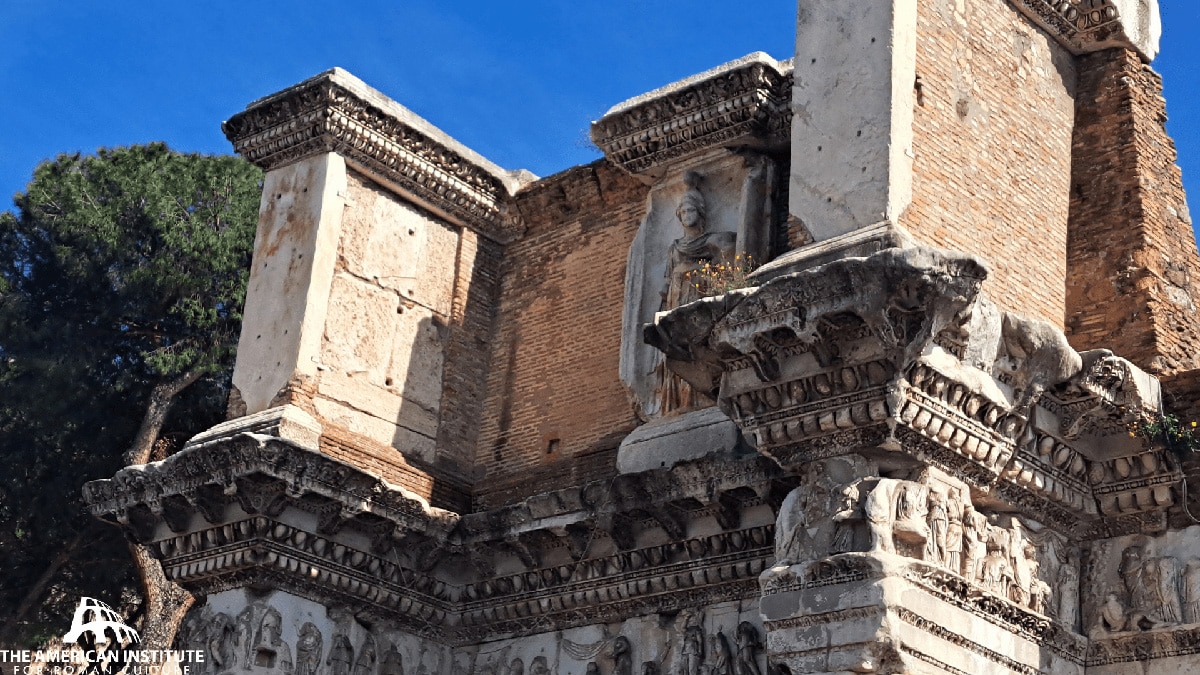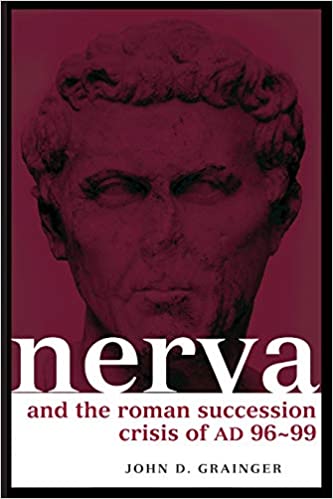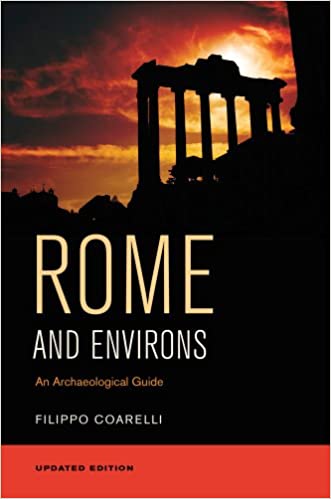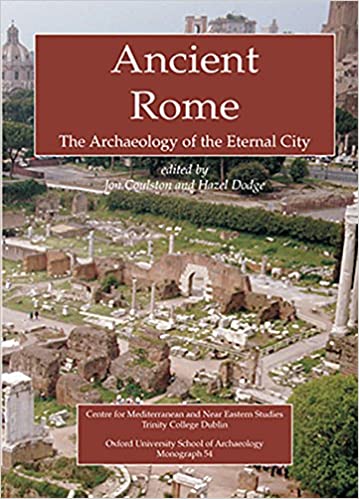The Temple of Minerva was part of the Forum of Nerva, a building complex begun by Emperor Domitian and completed by his successor, Emperor Nerva, in 97 CE. This forum was also known as the Forum Transitorium, because it acted as a narrow passageway connecting the larger imperial forums. Domitian dedicated the temple to Minerva, the Roman goddess of wisdom and war strategy, who was also his patron deity. When Nerva took over and finished the project, he chose not to change the temple’s dedication, keeping it as a tribute to Minerva.
The temple stood at the short end of the Forum of Nerva, tucked beneath the curved hemicycles of the nearby Forum of Augustus. It was built on a tall podium and had a grand façade with six Corinthian columns made of Phrygian marble, with three more columns on each side. At the back of the temple was a small apse that once held the cult statue of Minerva. Although little archaeological evidence of this apse survives today, its shape is known thanks to fragments of the Forma Urbis Romae, a massive ancient map of Rome carved in marble.
Running alongside the temple was a colonnade known today as le colonnacce, parts of which still stand. Above the columns is a large relief showing a female figure holding a helmet and shield. While commonly believed to be Minerva, some scholars think it might represent a Roman province. The frieze also illustrates the myth of Minerva and Arachne, a story where Arachne, a mortal, dared to challenge the goddess to a weaving contest. After Arachne insulted the gods through her art, Minerva punished her by turning her into a spider.
Remarkably, the temple and forum survived mostly intact for centuries after the fall of the Roman Empire. During the Middle Ages, the space was used for housing, and by the 16th century it served as part of Rome’s sewer system. In the 17th century, however, Pope Paul V ordered the temple’s demolition. Its marble and other valuable materials were taken to build the Fontana dell’Acqua Paola on Janiculum Hill and the Borghese Chapel in Santa Maria Maggiore.
Bibliography:
Arya, Darius. (2019). “Forum Nervae (Forum Transitorium, Forum of Nerva).” The American Institute for Roman Culture. https://ancientromelive.org/forum-nervae-forum-transitorium-forum-of-nerva/
Grout, James. (n.d). “Forum of Nerva.” University of Chicago. https://penelope.uchicago.edu/encyclopaedia_romana/imperialfora/nerva/forumnervae.html
Grout, James. (n.d). “Le Colonnacce.” University of Chicago. https://penelope.uchicago.edu/encyclopaedia_romana/imperialfora/nerva/colonnacce.html
Platner, Samuel. (1929). “Forum Nervae.” In A Topographical Dictionary of Ancient Rome (p.227-229). Retrieved from: https://penelope.uchicago.edu/Thayer/E/Gazetteer/Places/Europe/Italy/Lazio/Roma/Rome/_Texts/PLATOP*/Forum_Nervae.html
Rudolph, Becky. (2016). “The Temple of Minerva and Le Colonacce.” Wellesley University. http://omeka.wellesley.edu/piranesi-rome/exhibits/show/forum-of-domitian–nerva-trans/the-temple-of-minerva
MINERVA, TEMPLUM
* Among the buildings attributed to Domitian (Chron. 146) is a templum Castorum et Minervae, and the same designation is employed in the Regionary Catalogue (Cur. Reg. VIII, om. Not.). This would indicate either one structure, or two near together, an inference that is supported by the discovery of part of the statue of Minerva near the lacus Iuturnae (NS 1901, I 14, fig. 73).
Read more:
On the tabulae honestae missionis after 89 A.D. (CIL iii. Suppl. pp. 1965-2005, 2035),1 it is stated that the originals were placed in muro post templum diviAug. ad Minervam, and the same juxtaposition of these two temples is found in Martial (iv. 53. 1-2: Hunc, quem saepe vides intra penetralia nostrae / Palladiset templi limina, Cosme, novi). The shrine of Minerva should, then, be situated between the temple of Augustus and the temple of Castor, and many scholars have accepted Hulsen’s theory which identifies it with the large court (19 by 21 metres) which served later as the forecourt of S. Maria Antiqua, behind, i.e. east, of the temple of Augustus and in front of the building supposed to be the bibliotheca divi Augusti, or else with a smaller shrine standing in this court (HJ 83-84; Mitt. 1902, 79-80; HC 172-175 ; Th6d. 310; Tea in BA 1921, 356 sqq.; ZA 92-94; see also Gilb. iii. 45 ; Rosch. ii. 2990). Another explanation is that Domitian, after restoring the temple of Castor, rededicated it under the name of Castorum et Minervae (Mommsen, Chron. 354, P. 652). (For further particulars and the description of the ruins, see TEMPLUM D. AUGUSTI.)
A more recent theory (Richmond in Essays and Studies presented to William Ridgeway on his Sixtieth Birthday, Cambridge 1913, 206-211) is that the templum Minervae (Chronog. Cur. Mart. locc. citt. and CIL x. 6441)2 was a library erected by Domitian in honour of Minerva and really her chief temple in Rome, and that this structure comprised the complex of buildings of the time of Domitian, commonly called the templum d. Augusti and bibliotheca templi d. Augusti. The Minerva of the diplomas (v. supra) is the name given to part of the earlier library belonging to the temple of Augustus-although separated from it by a wall, which was built by Tiberius and lay south of the existing church of S. Teodoro. Still more recently Bartoli (BC 1924, 250-259) has maintained that the phrase ad Minervam refers to a statue, not to a temple at all; Chron. and Cur. cit. would then refer to the temple of Minerva in the forum Nervae (YW 1925-6, 113). The juxtaposition of the temple with that of Castor and Pollux is, however, strongly against this view.
This content is brought to you by The American Institute for Roman Culture, a 501(C)3 US Non-Profit Organization.
Please support our mission to aid learning and understanding of ancient Rome through free-to-access content by donating today.
Cite This Page
Cite this page as: Darius Arya, The American Institute for Roman Culture, “Minerva, Aedes (Forum Nervae)” Ancient Rome Live. Last modified 05/15/2025. https://ancientromelive.org/minerva-aedes-forum-nervae/
License
Created by The American Institute of Roman Culture, published on 05/15/2025 under the following license: Creative Commons: Attribution-NonCommercial-ShareAlike. This license lets others remix, tweak, and build upon this content non-commercially, as long as they credit the author and license their new creations under the identical terms. Please note that content linked from this page may have different licensing terms.








